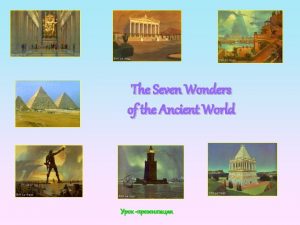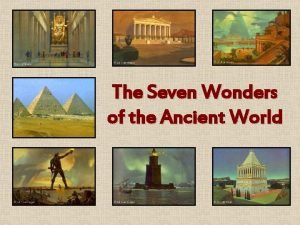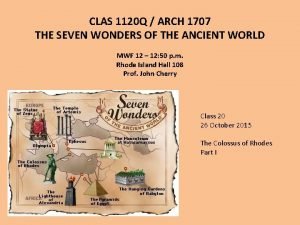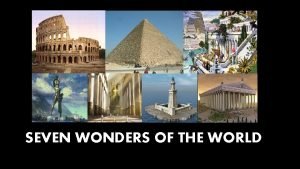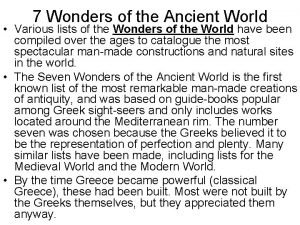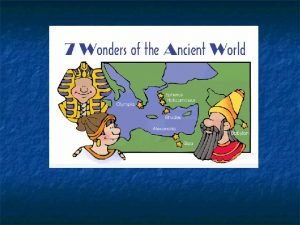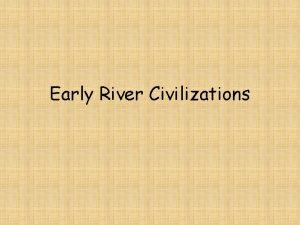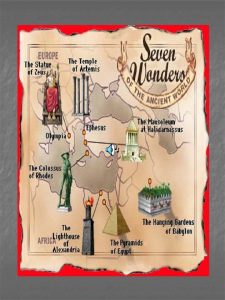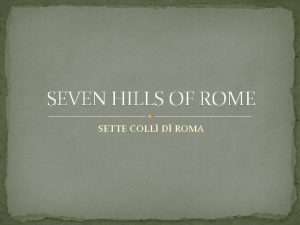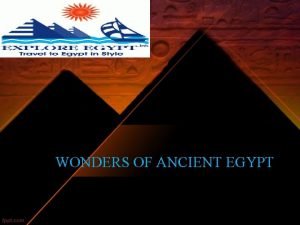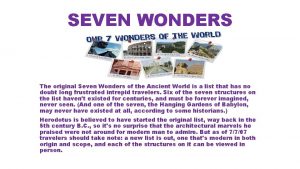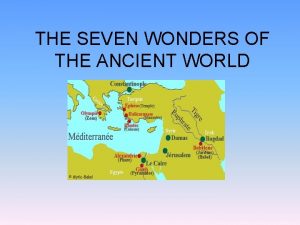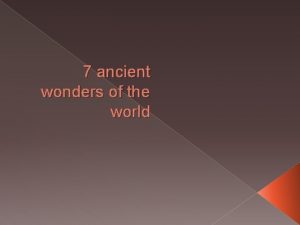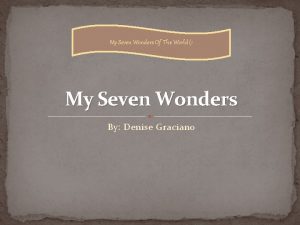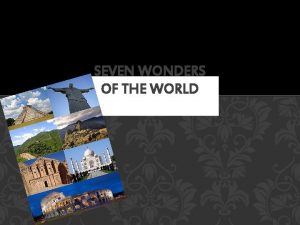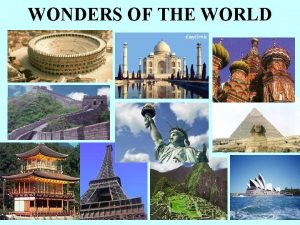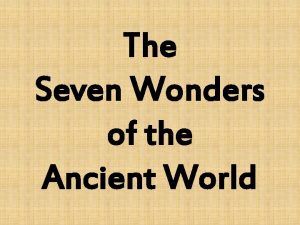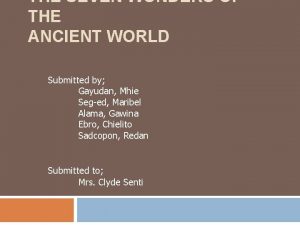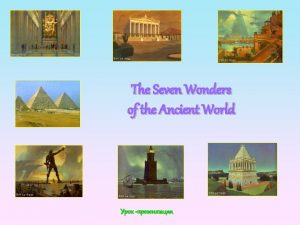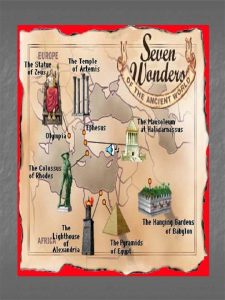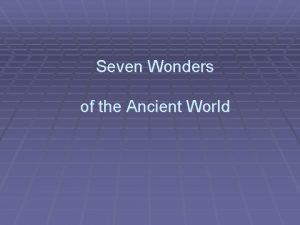THE SEVEN WONDERS OF THE ANCIENT WORLD MAP






















- Slides: 22

THE SEVEN WONDERS OF THE ANCIENT WORLD

MAP OF THE SEVEN WORDERS

CHEOPS PYRAMID

• The three large pyramids at Giza: From left to right, Menkaure, Khafre, Khufu. • The far pyramid is the "Great Pyramid" and the largest structure on the site. The middle one may look larger, but only because it is built on higher ground. • Egyptologists believe that the pyramid was built as a tomb over a 10 to 20 -year period concluding around 2560 BC.

Giza complex as it looked in 1904 from a balloon.

• The Great Pyramid was the tallest man-made structure in the world for over 3, 800 years. • There are many theories about the Great Pyramid's construction techniques. Most accepted construction hypotheses are based on the idea that it was built by moving huge stones from a quarry and dragging and lifting them into place. Cheop’s Pyramid: the secret entrance

Giza complex

THE COLOSSUS OF RHODES

• The Colossus of Rhodes was a statue of the Greek titan-god of the sun Helios, erected in the city of Rhodes, on the Greek island of the same name, by Chares of Lindos in 280 BC. • It is considered one of the Seven Wonders of the Ancient World. It was constructed to celebrate Rhodes' victory over the ruler of Cyprus.

THE HANGING GARDENS OF BABYLON

• The Hanging Gardens of Babylon were one of the Seven Wonders of the Ancient World, and the only one whose location has not been definitely established. • Traditionally they were said to have been built in the ancient city of Babylon, near presentday Hillah, Iraq by the. Neo. Babylonian king Nebuchadnezzar II.

• According to one legend, Nebuchadnezzar II built the Hanging Gardens for his Median wife, Queen Amytis, because she missed the green hills and valleys of her homeland. • He also built a grand palace that came to be known as 'The Marvel of the Mankind'.

THE LIGHTHOUSEOF ALEXANDRIA

• The Lighthouse of Alexandria, sometimes called the Pharos of Alexandria , was a lofty tower built by the Ptolemaic kingdom between 280 and 247 BC. • It was one of the tallest manmade structures on Earth for many centuries, and was regarded as one of the Seven Wonders of the Ancient World. • Badly damaged by three earthquakes between 956 and 1323, it became an abandoned ruin.

THE MAUSOLEUM AT HALICARNASSUS

• The Mausoleum at Halicarnassus or Tomb of Mausolus was a tomb built between 353 and 350 BC at Halicarnassus (present day Bodrum, Turkey) for Mausolus and Artemisia II, who was both his wife and his sister. • The Mausoleum was approximately 45 m in height, and the four sides were adorned with sculptural reliefs. • The finished structure of the mausoleum was considered to be such an aesthetic triumph that Antipater of Sidon identified it as one of his Seven Wonders of the Ancient World. It was destroyed by earthquakes from the 12 th to the 15 th century.

What is left of the Mausoleum of Alicarnasos

THE STATUE OF ZEUS AT OLYMPIA

• The Statue of Zeus at Olympia was a giant seated figure, about 13 m tall. • It was made by the Greek sculptor Phidias around 435 BC at the sanctuary of Olympia, Greece, and erected in the Temple of Zeus there.

• A sculpture of ivory plates and gold panels over a wooden framework. • It represented the god Zeus sitting on an elaborate cedarwood throne ornamented with ebony, ivory, gold and precious stones. • It was regarded as one of the Seven Wonders of the Ancient World.

THE TEMPLE OF ARTEMIS AT EPHESUS

• The Temple of Artemis or Artemision, was a Greek temple dedicated to the goddess Artemis and is one of the Seven Wonders of the Ancient World. • It was located in Ephesus(near the modern town of Selçuk in Turkey), and was completely rebuilt three times before its eventual destruction in 401.
 Collosus of rhodes
Collosus of rhodes Ancient wonders map
Ancient wonders map Seven woders of the world
Seven woders of the world 7 wonders of the ancient world map
7 wonders of the ancient world map Jocelyn vazquez
Jocelyn vazquez Seven wonders of the world 2012
Seven wonders of the world 2012 Salvador dali seven wonders
Salvador dali seven wonders Woders of the world
Woders of the world 7 wonders of the ancient world names
7 wonders of the ancient world names New seven wonders foundation
New seven wonders foundation Taj mahal seven wonders
Taj mahal seven wonders 7 wonders of ancient greece
7 wonders of ancient greece 7 woders of the world
7 woders of the world River valley civilization
River valley civilization Old 7 wonders of the world
Old 7 wonders of the world What are the literary elements of a folktale
What are the literary elements of a folktale Wonders of the world
Wonders of the world Wstuaries
Wstuaries 7 sins 7 virtues
7 sins 7 virtues Seven hills of ancient rome
Seven hills of ancient rome Ancient time ancient means of communication pictures
Ancient time ancient means of communication pictures Ancient india vs ancient china
Ancient india vs ancient china An elementary school classroom in a slum poem analysis
An elementary school classroom in a slum poem analysis
